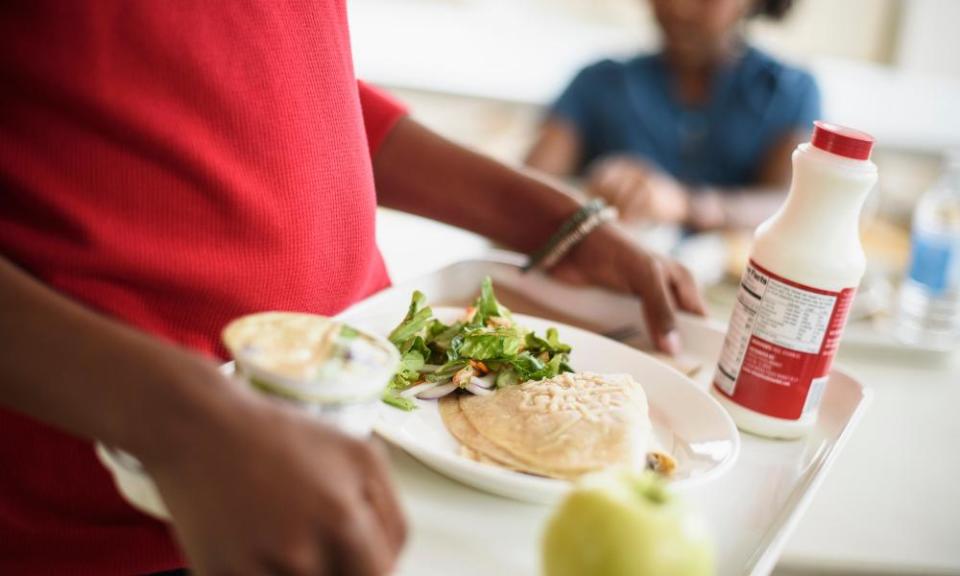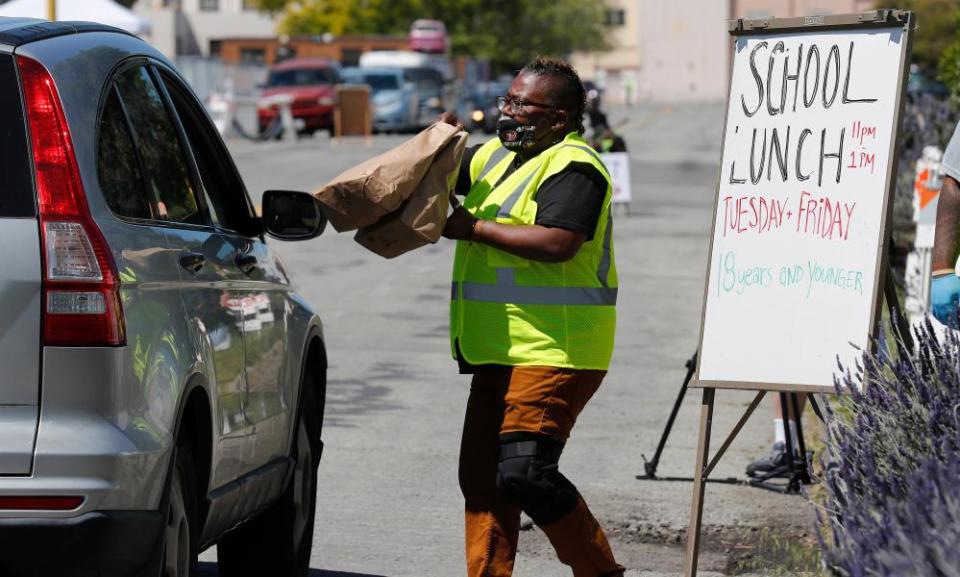Free US school lunches were a dream come true. Now, a hunger crisis looms for 10 million children

For the last two years, the notion that no kid should ever have to go hungry in the US has gotten closer to a reality, thanks to federal waivers that have expanded children’s access to food. The waivers resulted in a simple but revolutionary outcome: free lunch, year-round, for every American schoolchild.
Related: ‘The most amazing link to our history’: the farmers reclaiming their heritage one seed at a time
But that will come to an end in weeks, as Congress has failed to include an extension of the waivers, which have allowed schools to offer school lunches as well as summer lunch handouts, enabling an estimated 10 million more students to get a free meal.
Now, as rising prices hit families and school food programs alike, the program’s expiration will cause a cliff that some parents, cafeteria workers and nutrition advocates say could cause a catastrophe.
Ample research shows the educational, health and behavioral benefits for students who eat breakfast and lunch. But millions of students cannot afford to pay a full-price school lunch, and a pre-pandemic survey by the School Nutrition Association found as many as 75% of school districts in America have unpaid student meal debt.
Under the old rules, for a student to qualify for a subsidized meal, a student’s family would have to submit an application including some of their financial information. These applications are complicated and can cause embarrassment, according to Jillien Meier, the director of No Kid Hungry, a food access advocacy group.
“Particularly for kids in communities where there were lower to moderate poverty rates, there’s a huge stigma attached to free meals and parents maybe didn’t want their kids identified that way,” she said.
Now, those students are no longer treated differently. In March 2020, Congress allowed the United States Department of Agriculture (USDA) to implement child nutrition waivers, which enable schools to be reimbursed at higher rates for serving free food to all students, regardless of the students’ ability to pay. Under these more flexible rules, families no longer have to fill out applications for students to receive free lunches at school, and schools have been able to expand their food distribution methods, including handing out curbside meals to students during lockdown.

The waivers also dramatically expanded the USDA’s Summer Food Service Program, by eliminating geographical requirements, and allowing community groups to bring food directly to people in bulk. “They took meals to housing authorities. They took meals door to door. They bundled meals so that families that were quarantining could come out one time a week and pick up seven days’ worth of meals,” said Meier.
The result was a cumulative 4.3bn meals distributed through the service program over the last two summers alone, a roughly thirtyfold increase over pre-pandemic levels, according to federal statistics.
For Candice, a single mom of two boys in Michigan who has been sick and unable to work, the expanded food programs have been a lifeline.
At the beginning of the pandemic, her school district set up a food giveaway. “Basically there were two different times you could drive up, say how many kids you had, and you got enough food for breakfast and lunch until the next time,” she told the Guardian.
The bundles were packed: “A lot of fruits and vegetables, milk, juice, water. Everything a school has for lunches was in the box, and it was double: chicken nuggets and sandwiches, mini corn dogs, hamburgers, pizza, fries, tots, subs. For breakfast, there was cereal, bagels; they even had the sausage wrapped in a pancake.”
During the first Thanksgiving in the pandemic, she said, the school’s principal even brought her a complete Thanksgiving dinner to cook.
If it weren’t for the expanded programs, “I would take the blow, like not eating myself just to make sure my kids had enough to eat,” she said. “No child should have to be hungry in school or anywhere else.”
When the waivers expire on 30 June, the impact will be felt almost immediately, said Meier, when the summer meals program launches with far fewer participating sites.
You might want to say Covid is over. But the tattered remains of our supply chain … should really serve as an eye-opener that this is not a normal time
Jillien Meier
Food service vendors, sensing Congress’s lack of interest in renewing the expanded food programs, have already shifted their focus from the school market to the more profitable consumer market. For schools, that has exacerbated already dire supply chain issues.
“I think we’re going to see in real time the summer hunger crisis grow, and that’s going to give us a preview of what’s going to happen next school year,” said Meier.
When the national school lunch program restarts in the fall without the waivers, schools will be required to meet pre-pandemic nutritional requirements – which may no longer be feasible given ongoing supply chain problems.
Catherine, a school cafeteria manager in Arkansas, told the Guardian she had been struggling to order more nutritious items such as whole grain waffles or pancakes. “It’s not just the foods are expensive, they are getting harder to find,” she said.
Like many other cafeteria workers, Catherine said she had been forced to get creative: “I never encountered anything I couldn’t substitute.” But this strategy has only worked because waivers have given cafeteria managers more flexibility.
Once the waivers expire, schools will be fined for making any substitutions that don’t meet nutritional and meal planning guidelines – hitting already slim budgets.
And with the expanded free lunch subsidies expiring, cafeterias will be put in a tight spot.
Catherine said before the pandemic, many parents were reluctant to fill out an application for free and reduced-price meals. “Even though some of them would qualify, they don’t want anyone knowing their finances,” she said.
As a result, many students simply accrue meal debt – which cafeterias have few means to collect. “You can’t call and harass parents. That’s against the rules.”

For Catherine, the solution is simple: continue the current program. “If all students were fully paid, we would never be in the negative and would be able to provide better meals for students.”
The waivers aren’t without their issues. An Oklahoma cafeteria worker named Jenelle told the Guardian that while she saw the “tremendous benefits” of free lunch, she said her school exploited the waivers and caused food waste. “The idea was to get as many kids as possible to take a meal or bag, even if they didn’t need it so the food service contract could claim that meal to get paid,” she said. “We gave sub par, barely edible food, with tiny portions and no choices because it was free and reimbursed.”
Some states, like California and Maine, have passed universal free school meal programs, and other states, like New York, Colorado, Massachusetts and Vermont, have recently introduced legislation to pay for universal free school meals.
But for now, there appears to be scant political will to continue the waivers on Capitol Hill. The Biden administration didn’t include the extensions in its latest $1.5tn spending bill, reportedly at the insistence of the Senate minority leader, Mitch McConnell. McConnell has not commented publicly on the issue, and his office did not respond to a request for comment. But a GOP aide told Politico in March that it was no longer necessary to expand school nutrition programs more than two years into the pandemic.
Meier called the decision enraging. “You might want to say Covid is over. But the tattered remains of our supply chain, and the fact that schools are worried about if there will be any food for them to serve next year, should really serve as an eye-opener that this is not a normal time,” she said. “ The providers need it. And yet Congress continues to do nothing.”

